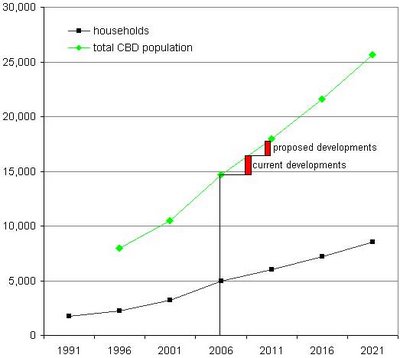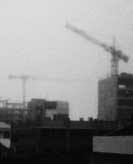Future city
In a recent post, I mentioned that I had seen projections of an extra 3,000 inner-city residents within the next few years, but that I couldn't find a reference to the study. As it turns out, the campaigners against the controversial Harbour Quays development have come to my rescue: their report on the potential economic impacts (530kB PDF) includes a table of actual and forecast CBD household numbers from 1991 to 2021 (page 14). They list the sources as Statistics NZ, Bayleys and Property Economics (the authors of the report), but I couldn't find out whether the future figures were based upon economic and demographic modelling or simple extrapolation.
But let's take the numbers as read, and use them to estimate the increase in inner-city population by taking a nominal average household size of 3. This is a bit smaller than the current average for the CBD, but household sizes are generally falling, so it seems a reasonable guesstimate. This gives an extra 3,300 people by 2011, and 11,000 extra by 2021: a 75% increase over the current CBD population!
My earlier study showed that over 3,000 new residents could be housed in apartments already proposed or under construction. How do these fit into the population projections? Here's a graph to show them in context:

The red bars show that these pending developments could absorb projected demand for the next 4 or 5 years. If demand for inner-city living continues as forecast (and that's a big if: a bird-flu scare or another Peter Jackson could skew the trend in either direction), what are the implications for inner Wellington's urban form?
 Get used to cranes. Once way or another, a lot of construction will be needed. Some vacant office space will be converted to apartments, but that would only house about 1,000-1,500 people. There's still a lot of vacant and underutilised land in Te Aro: I once worked out that if you redeveloped all the car sales yards and single-storey bulk retailers you could house about 6,000 people without going over 6 storeys, and without displacing existing tenants. Where will the other 3,500 people go? We could always build higher throughout Te Aro (and probably will), but that might not be ideal. Perhaps turning Harbour Quays into a low-density single-use office park, rather than a mixed-use inner-city precinct, really is a bad idea.
Get used to cranes. Once way or another, a lot of construction will be needed. Some vacant office space will be converted to apartments, but that would only house about 1,000-1,500 people. There's still a lot of vacant and underutilised land in Te Aro: I once worked out that if you redeveloped all the car sales yards and single-storey bulk retailers you could house about 6,000 people without going over 6 storeys, and without displacing existing tenants. Where will the other 3,500 people go? We could always build higher throughout Te Aro (and probably will), but that might not be ideal. Perhaps turning Harbour Quays into a low-density single-use office park, rather than a mixed-use inner-city precinct, really is a bad idea.Walk on the left. Most of those people are going to walk to work. That's fantastic for the environment, of course, but parts of the Golden Mile already have more foot traffic than the busiest shopping streets in London, and are pretty much at congestion point during rush hour and lunchtime. Good urban etiquette will help a bit, but perhaps we need to spread the walkers out a bit. Anything that creates extra pavement space will be welcome, but making the waterfront route a more realistic foot-commuting option (through more shelter and easier road crossings) should be a priority. So should improving public transport within the CBD: recent bus-lane improvements have made a difference, but light rail would be even better.
Plan ahead. It's hardly the explosive growth that's made life difficult in Auckland (let alone Shanghai or Dubai!), but it could still get out of hand unless we plan ahead. By "we", I mean the councils, transport providers and so on, of course, but many other groups have a part to play. Architects need to set standards for quality high- and medium-density housing. Developers need to realise that their buildings aren't purely private property, but are part of the urban fabric and help define the public realm. Residents need to develop mature give-and-take attitudes to city living. Retailers and hospitality operators should look for opportunities to provide new services such as home delivery and a new generation of local shops, markets and cafés.
Enjoy the ride. If there's any predictive value in the fact that a past influx of 4,000 residents was associated with a net increase of approximately 45 bars, cafés and restaurants (based on my earlier post), then we can expect even more growth in the hospitality sector. That should offer more choice for everyone and greater vitality for the city as a whole, and I for one am looking forward to it. Certainly, the sector seems quite healthy at the moment, with almost all of the places that closed in the past year either already reopened or set to do so, and there are brand new places in the offing for the waterfront and elsewhere. Compare the dull and desolate Wellington of 15 years ago with what we enjoy today, then extrapolate the difference into the future. Okay, there's no scientific way to measure the buzz or "x-factor" of a city, let alone correlate it with something as mundane as a population increase, but it's a fair bet that our density and diversity is what makes us more exciting than other NZ cities. If we can increase that even further, while planning ahead to avoid the potential negative impacts, there's a truly wonderful city waiting for us in the future.



1 Comments:
with these sort of predictions light rail seems essential-
Perhaps it could do a wee kink into "Harbour Quays" enroute between the railway station and kaiwharawhara
Post a Comment
<< Home